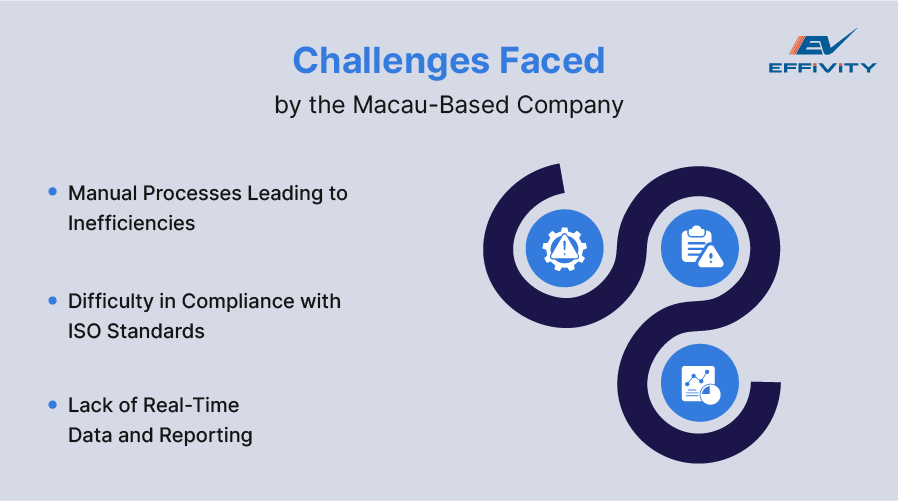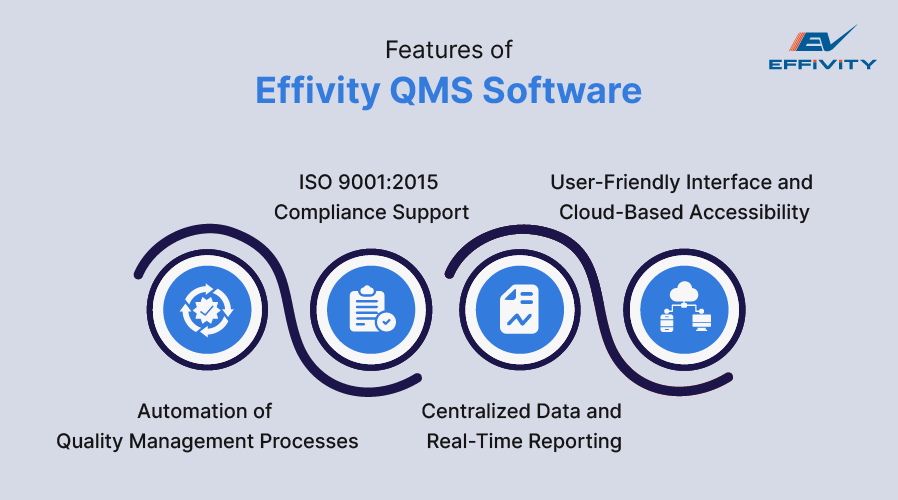Achieving compliance is a key goal for any business aiming to remain competitive and relevant in today’s fast-paced world. For a Macau-based technical services provider, ensuring the highest standards of quality was essential to drive continual improvement and maintain compliance.
However, achieving these standards within a highly regulated industry can be challenging. The regulatory environment is complex and ever-changing. Moreover, manual processes can affect how companies manage and implement management systems, making it difficult to comply with the various ISO standards.
A Macau-based company was dealing with the same, looking for a robust quality management system software to enhance its organizational efficiency and drive improvement. This is where Effivity entered into the picture.
Let’s see how Effivity QMS for technical service providers helped improve the company’s processes and compliance.
About the Company
A technical service provider company in Macau offered technical assistance, cloud support, cybersecurity services, and other technical services to its clients from across the globe. The company dealt with a range of IT services and managed tons of sensitive data for its clients, which required the company to adhere to various regulatory requirements.
The compliance requirements were strict and ever-evolving from protecting client data and ensuring the quality of its security systems to managing and addressing security risks. In such a dynamic compliance environment, the Macau-based company struggled to keep up with the compliance needs, inefficient audits, and a manual approach to quality management.
Challenges Faced by the Macau-based Company
The Macau-based technical services provider encountered several hurdles in maintaining and improving their quality management processes. These challenges can be broken down into a few core areas:

1. Manual Processes Leading to Inefficiencies
The company relied heavily on manual methods for tracking and managing quality-related data. This included paper-based forms, spreadsheets, and fragmented digital tools. These processes led to inefficiencies and increased the risk of human error.
Tasks like document control, non-conformance tracking, and internal audits were time-consuming, prone to mistakes, and lacked centralization.
2. Difficulty in Compliance with ISO Standards
While the company had a basic quality management framework, ensuring compliance with ISO 9001:2015 was a continual struggle. The lack of an automated system meant meeting international standards required more manual oversight, often leading to delays and audit failures.
Without clear workflows or automated reminders for required tasks, there were occasional lapses in mandatory compliance activities, such as document reviews and planning corrective actions.
3. Lack of Real-Time Data and Reporting
Quick access to up-to-date information for quality and compliance-related tasks was another major issue. The manual processes did not provide management with real-time insights into the status of their quality performance. As a result, any decision-making was reactive rather than proactive.
The inability to easily generate reports on key metrics like non-conformities, corrective actions, or customer satisfaction further hindered the company’s ability to address any security risks in its operations and take corrective measures.
The technical services provider experienced a disconnect between identifying issues and planning comprehensive internal audits, affecting the company’s quality management approach.
Effivity QMS Software Emerged as an Excellent Solution
To overcome these challenges and consistently meet the customers’ requirements with their services, the Macau-based technical service provider decided to adopt a more streamlined and holistic approach to managing their quality management system.
Their extensive search led them to Effivity. After a detailed demonstration of the Effivity QMS Software, the company chose the tool to take control of its quality management.
Effivity Quality Management Software offers a range of modules such as document control, non-conformance, Corrective and Preventive Actions (CAPA), Risk management, Change Management, Complaint handling, and many others, making it an indispensable tool for an organization’s overall quality control.
Its Interactive dashboards and reports allow companies to analyze its performance and deliver actionable insights. What’s more, the tool is highly user-friendly and integrates seamlessly with your existing systems, ensuring your employees can quickly automate and manage QMS processes.
The tool proved to be a game changer for the Macau-based company, helping them-
- Improve data visibility and traceability
- Save costs and time spent on manual processes and audits
- Take a proactive approach to risk and quality management to offer enhanced technical services
- Access critical information anytime, anywhere.
- Ensure easy follow-up for various corrective actions or audit-related tasks with timely email and system notifications.
“Effivity has helped us save a considerable amount of time and resources, thereby allowing us to focus more on business operations and continuous innovation,” said Quality Systems Manager from Service Provider
Features of Effivity QMS Software
Effivity QMS software is designed to address many of the common challenges businesses face seeking to maintain high-quality standards. The software provides a range of features that cater to companies in regulated industries, such as technical services, ensuring compliance, efficiency, and continual improvement.

1. Automation of Quality Management Processes
One of the key features of Effivity QMS software is its ability to automate a wide range of quality management activities. From document control to non-conformance tracking, automation significantly reduces manual effort, allowing teams to focus on core business activities rather than administrative tasks.
2. ISO 9001:2015 Compliance Support
Effivity’s QMS software is built with ISO 9001:2015 requirements in mind, offering modules that specifically cater to ensuring compliance with international standards. The software provides pre-configured workflows for corrective actions, audits, and risk assessments, which help organizations seamlessly meet ISO requirements without complex customizations.
3. Centralized Data and Real-Time Reporting
Effivity’s QMS software centralizes all quality-related data in one place, making it accessible to management in real-time. The platform also offers customizable dashboards and reporting features that allow decision-makers to gain insights into key performance indicators (KPIs) like non-conformities, audit results, and customer complaints.
4. User-Friendly Interface and Cloud-Based Accessibility
Effivity’s cloud-based nature means that the software can be accessed from anywhere, providing flexibility for teams across multiple locations. Its user-friendly interface ensures that employees can quickly adapt to the system without extensive training.
Conclusion
The Macau-based technical services provider’s experience with Effivity QMS software highlights the importance of using the right tools to drive continual improvement. Effivity’s QMS software provided the company with the capabilities it needed not only to meet but exceed its quality goals, proving that automation and intelligent quality management solutions are key to thriving in today’s business landscape.
To explore the capabilities and unique features of the Effivity QMS software, connect with our experts and start your free trial today!
Frequently Asked Questions
1. How does Effivity QMS software help in improving ISO 9001:2015 compliance?
Effivity QMS software comes with pre-configured workflows that cater to ISO 9001:2015 standards. It automates corrective actions, risk assessments, and internal audits, ensuring compliance without requiring complex manual processes or additional customizations.
2. Can Effivity QMS software integrate with existing systems for a technical services provider?
Yes, Effivity QMS is designed to integrate seamlessly with existing operational systems. Its user-friendly interface and cloud-based accessibility make it easy to implement without disrupting current workflows, allowing for centralized quality management across departments.



























